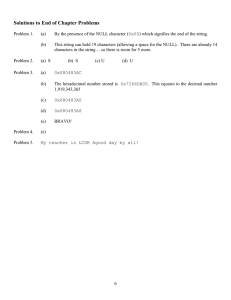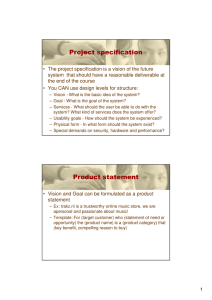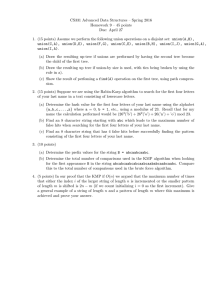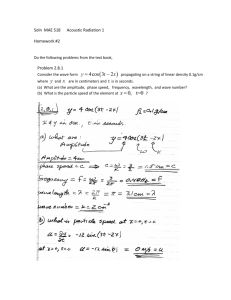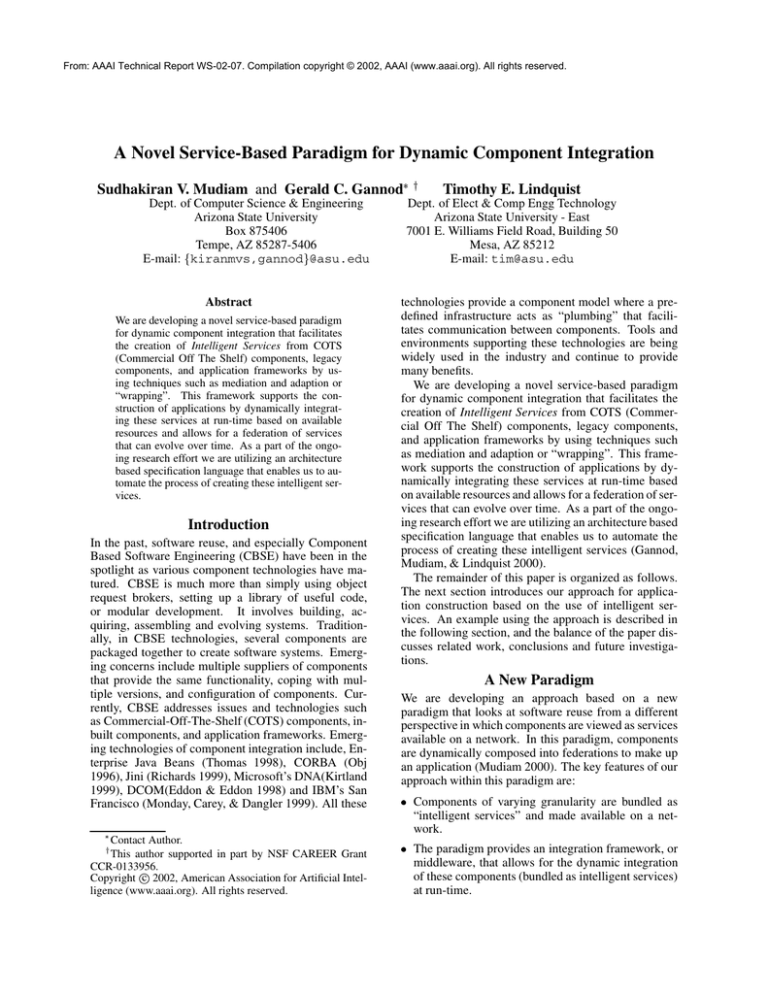
From: AAAI Technical Report WS-02-07. Compilation copyright © 2002, AAAI (www.aaai.org). All rights reserved.
A Novel Service-Based Paradigm for Dynamic Component Integration
Sudhakiran V. Mudiam and Gerald C. Gannod£
Dept. of Computer Science & Engineering
Arizona State University
Box 875406
Tempe, AZ 85287-5406
E-mail: kiranmvs,gannod@asu.edu
Abstract
We are developing a novel service-based paradigm
for dynamic component integration that facilitates
the creation of Intelligent Services from COTS
(Commercial Off The Shelf) components, legacy
components, and application frameworks by using techniques such as mediation and adaption or
“wrapping”. This framework supports the construction of applications by dynamically integrating these services at run-time based on available
resources and allows for a federation of services
that can evolve over time. As a part of the ongoing research effort we are utilizing an architecture
based specification language that enables us to automate the process of creating these intelligent services.
Introduction
In the past, software reuse, and especially Component
Based Software Engineering (CBSE) have been in the
spotlight as various component technologies have matured. CBSE is much more than simply using object
request brokers, setting up a library of useful code,
or modular development. It involves building, acquiring, assembling and evolving systems. Traditionally, in CBSE technologies, several components are
packaged together to create software systems. Emerging concerns include multiple suppliers of components
that provide the same functionality, coping with multiple versions, and configuration of components. Currently, CBSE addresses issues and technologies such
as Commercial-Off-The-Shelf (COTS) components, inbuilt components, and application frameworks. Emerging technologies of component integration include, Enterprise Java Beans (Thomas 1998), CORBA (Obj
1996), Jini (Richards 1999), Microsoft’s DNA(Kirtland
1999), DCOM(Eddon & Eddon 1998) and IBM’s San
Francisco (Monday, Carey, & Dangler 1999). All these
£ Contact Author.
Ý This author supported in part by NSF CAREER Grant
­
CCR-0133956.
Copyright c 2002, American Association for Artificial Intelligence (www.aaai.org). All rights reserved.
Ý
Timothy E. Lindquist
Dept. of Elect & Comp Engg Technology
Arizona State University - East
7001 E. Williams Field Road, Building 50
Mesa, AZ 85212
E-mail: tim@asu.edu
technologies provide a component model where a predefined infrastructure acts as “plumbing” that facilitates communication between components. Tools and
environments supporting these technologies are being
widely used in the industry and continue to provide
many benefits.
We are developing a novel service-based paradigm
for dynamic component integration that facilitates the
creation of Intelligent Services from COTS (Commercial Off The Shelf) components, legacy components,
and application frameworks by using techniques such
as mediation and adaption or “wrapping”. This framework supports the construction of applications by dynamically integrating these services at run-time based
on available resources and allows for a federation of services that can evolve over time. As a part of the ongoing research effort we are utilizing an architecture based
specification language that enables us to automate the
process of creating these intelligent services (Gannod,
Mudiam, & Lindquist 2000).
The remainder of this paper is organized as follows.
The next section introduces our approach for application construction based on the use of intelligent services. An example using the approach is described in
the following section, and the balance of the paper discusses related work, conclusions and future investigations.
A New Paradigm
We are developing an approach based on a new
paradigm that looks at software reuse from a different
perspective in which components are viewed as services
available on a network. In this paradigm, components
are dynamically composed into federations to make up
an application (Mudiam 2000). The key features of our
approach within this paradigm are:
Components of varying granularity are bundled as
“intelligent services” and made available on a network.
The paradigm provides an integration framework, or
middleware, that allows for the dynamic integration
of these components (bundled as intelligent services)
at run-time.
The paradigm facilitates the use of various patterns of
interaction (architectural styles) between clients and
intelligent services.
The intelligent services provide a clear set of interfaces that are discovered dynamically at run-time and
achieved using filters and adapters.
The process of component integration consists of the
following steps.
1. Specification of the components as services.
2. Generation of the services along with the appropriate
adapters and storing them to a repository.
3. Specification of a client to make use of services from
the repository.
4. Generation of the client.
5. Execution of the client, performs the integration of
the specified services at runtime.
Steps 1 and 2 are typically performed only once for
each service while Steps 3 through 5 are performed as
needed for each application. One of the primary goals
of this work is the use of automatic synthesis to generate the source code necessary to achieve service integration. Our preliminary investigations have yielded
an approach for generating wrappers of legacy applications for use as services (Gannod, Mudiam, & Lindquist
2000). In this work, a specification of a legacy software
is created that defines the interface to a potential service. Second, the appropriate adapter source code is
then synthesized based on the specification.
In order to specify how applications are to be integrated, we use the ACME architecture description language (ADL) (Garlan, Monroe, & Wile 1997) to describe both the available services as well as the client
components that utilize those services. These specifications capture the interface of the components in such
a way that the services can be regarded as black-boxes
while remaining loosely coupled from implementation
details.
Once the services are generated and stored in a repository, clients can make use of these services by identifying a general class of service that is required and the
architectural style is necessary to properly interact with
a client. This work addresses several issues that need to
be considered during application specification and construction including:
The specification of application architectures
The specification of a component type in order to
manage style interactions
Graphical user interface integration including the use
of shared graphical features
Again, using the ACME ADL, an application architecture is specified in order to describe the client
composition and to identify the service classes that are
needed by the application. Using this specification, the
source code necessary to realize integration is generated
(but is not bound to specific services). The remaining
source code for the client, as with all applications, is
provided by the user.
Integration of all services in our paradigm is performed with the execution of clients as each service becomes available. At first a client registers with a lookup
service. Once services become available and join the
network, the client is notified. The client integrates with
the services by performing the GUI component integration as well as the service adapter integration and utilizes the service.
The research described above makes use of
Jini (Richards 1999) technology to realize service integration. The components are wrapped as Jini services
and we make use of the discovery and join mechanism
to enable services join a Jini network.
Example
Figures 1 and 2 depict specifications of a client component and a number of services, respectively. In this example, the client consists of an editor that needs to utilize version management, printing, and compiling services. When the client runs, it joins the Jini network
using Jini’s discover and join protocol. As shown in the
specification in Figure 1, the services that are required
by the client are described as ports to which services
will be bound.
Component Editor = {
Properties {
Part-of-client :
string = "true";
GUI-CodeFile :
string = "ClientGUICode.java";
Component-type :
string = "Call Return";
};
Port VM_Port = {
Properties {
Port-type :
string = "caller"; };
};
Port COMPILING_PORT = {
Properties {
Port-type :
string = "caller"; };
};
Port PRINTING_PORT = {
Properties {
Port-type :
string = "caller"; };
}; };
Figure 1: Client Specification
The specifications of the services, as shown in Figure 2, describe each of the available services in the integration network. In this example we show only the
specification of the RCS service and provide stubs for
other services. Note that the other services would indeed be specified in the same manner as the RCS service. Each of the port specifications in a service com-
ponent describe associated services. As such, the RCS
service could potentially have sub-services for check in
and check out.
Component RCS = {
Properties {
Component-type :
string = "Call Return";
};
Port ChkIn = {
Properties {
Signature :
string = "String filename,
String params, String filedata ";
Return :
string = "Boolean result";
Cmd :
string = "ci + filename + params";
Pre :
string =
"WriteFileData(filedata,filename)";
Post :
string = "";
Interface :
string = "VersionManagement";
Path :
string = "C:\\RKTOOLS\\BIN\\CI.EXE ";
Port-type :
string = "callee";
}; }; };
Component Lzpr = {
Properties {
Component-type :
string = "Call Return";
};
Port Print = {
Properties {
......
}; }; };
Component Javac = {
Properties {
Component-type :
string = "Call Return";
};
Port Compile = {
Properties {
......
}; }; };
Figure 2: Services Specification
Initially, when no services are available, the client
only has its editing GUI component as shown in Figure 3. However, since the client has access to the list
of services that it needs, it utilizes the lookup services
on the Jini network in order to complete service integration. As each service comes up and joins the Jini network, the client learns its existence and integrates them
into the client. The Figure 4 shows the result of the integration once all the services have joined the network.
In this example, we have a version management service called the RCSService, a compiling service called
JavacService and a printing service called lzprService.
Figure 3: Initial Client
Related Work
Sullivan et al. look at systematic reuse of large-scale
software components via static component integration (Sullivan et al. 1997). That is, they use an
OLE-based approach for component integration. To
demonstrate the use of their scheme, they developed a
safety analysis tool that integrates application components such as Visio and Word. In our approach we use a
dynamic approach for component integration and thus,
can utilize a wide variety of components whose interfaces are discovered at run-time.
CyberDesk (Dey et al. 1997) is a component-based
framework written in Java that supports automatic integration of desktop and network services. This framework is flexible and can be easily customized and extended. The components in this framework treat all data
uniformly regardless of whether the data came from a
locally running service or the World Wide Web. The
goal of this framework is to provide ubiquitous access
to services. This approach is similar to our proposed
approach in that they use a dynamic mapping facility to
support run-time discovery of interfaces.
Conclusions
The availability of components on a network that provide services at run-time has many potential applications including the use of heterogeneous components
executing in distributed environments. Enabling technologies such as Jini allow for dynamic component
integration. We have described an architecture-based
methodology of building components for reuse, and
later using them with in a larger context to build applications.
We are currently building an environment for supporting the specification and synthesis of applications
that utilize services through dynamic integration. The
current state of this work includes tools for sythesizing
both service and client integration code. We have used
these tools to generate examples including the one described in this paper. Our future investigations include
developing an approach for dynamically generating mediators to facilitate service interactions that bypass the
need to communicate via client applications.
References
Dey, A. K.; Abowd, G.; Pinkerton, M.; and Wood,
A. 1997. Cyberdesk: A framework for providing
Figure 4: Client After Integration
self-integrating ubiquitous software services. Technical Report GIT-GVU-97-10, Georgia Tech.
Eddon, G., and Eddon, H. 1998. Inside Distributed
COM. Microsoft Press.
Gannod, G. C.; Mudiam, S. V.; and Lindquist, T. E.
2000. An architecture-based approach for synthesizing and integrating adapters for legacy software. In
Seventh Working Conference in Reverse Engineering,
128–137. IEEE Computer Society.
Garlan, D.; Monroe, R. T.; and Wile, D. 1997. Acme:
An Architecture Description Interchange Language. In
Proceedings of CASCON’97, 169–183.
Kirtland, M. 1999. Designing Component-Based Applications: Build Enterprise Solutions with Microsoft
Windows DNA. Microsoft Press.
Monday, P.; Carey, J.; and Dangler, M. 1999. SanFrancisco Component Framework: An Introduction.
Addison-Wesley.
Mudiam, S. V. 2000. A novel service based paradigm
for dynamic component integration. Ph.D. Proposal,
Arizona State University.
Object Manangement Group. 1996. CORBA: Architecture and Specification V2.0, formal/97-02-25 edition.
Richards, W. K. 1999. Core Jini. Prentice-Hall.
Sullivan, K. J.; Cockrell, J.; Zhang, S.; and Coppit, D.
1997. Package oriented programming of engineering
tools. In Proceedings of the International Conference
on Software Engineering, 616–617.
Thomas, A. 1998. Enterprise java beans technology.
Technical report, Patricia Seybold Group.

